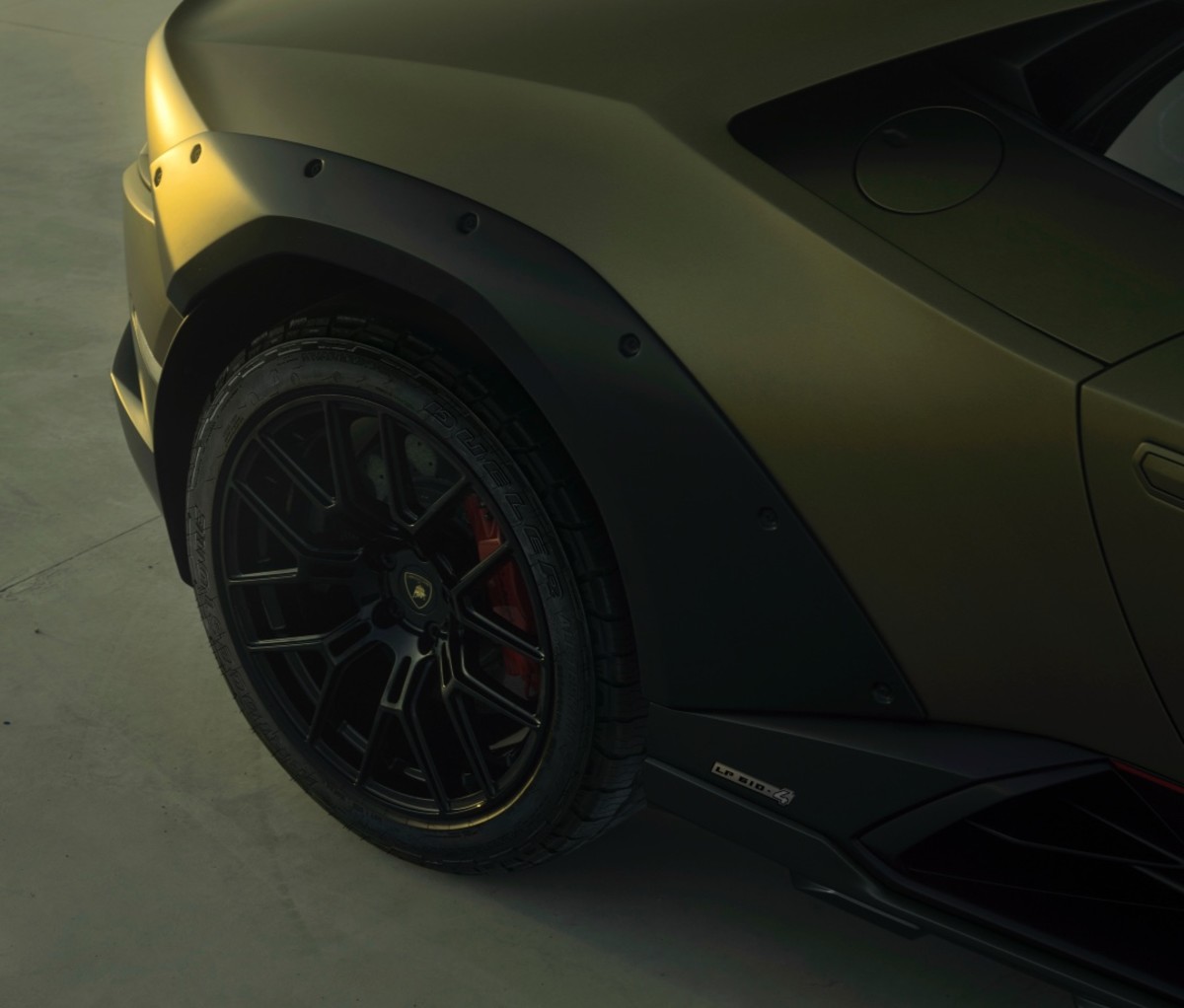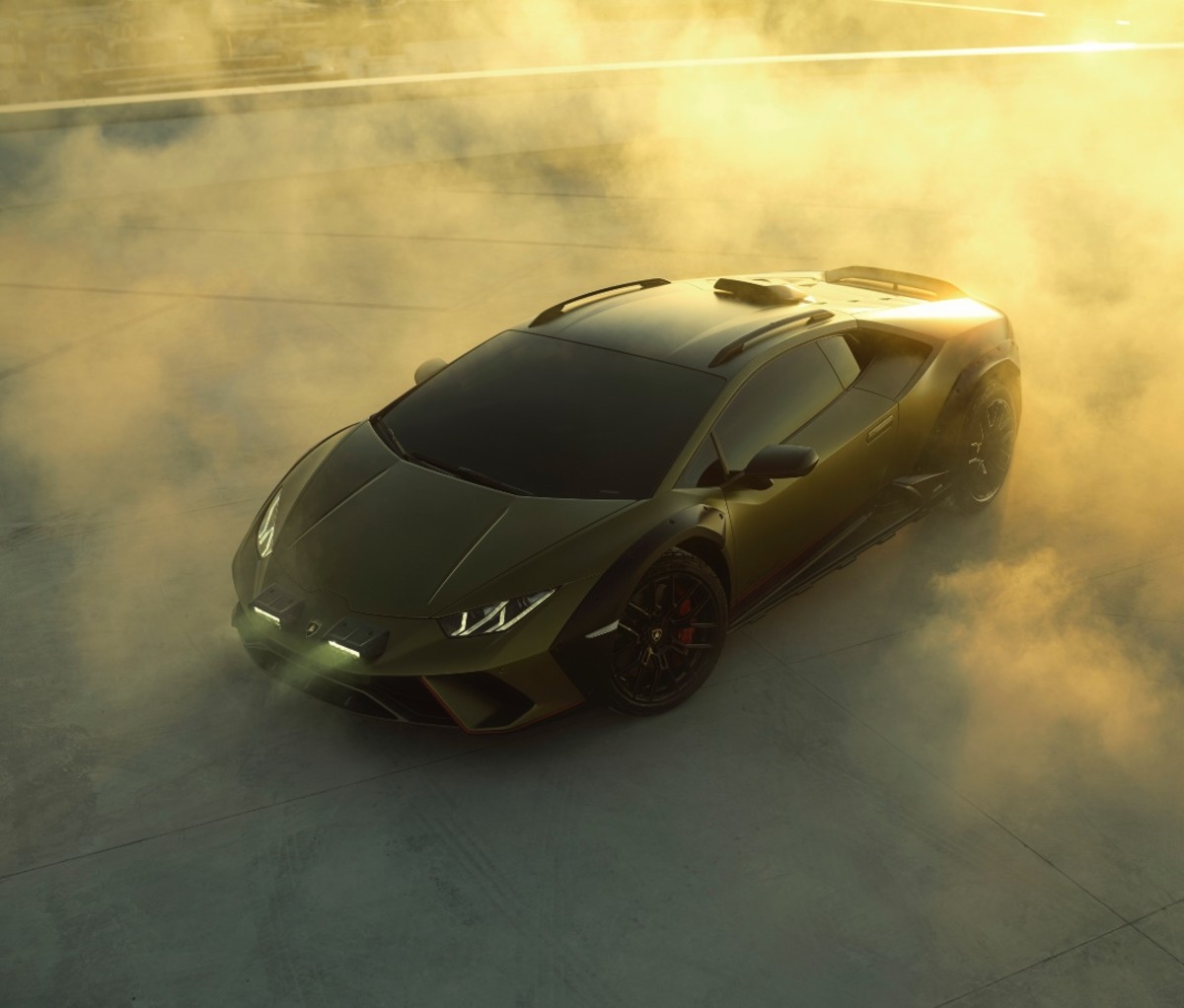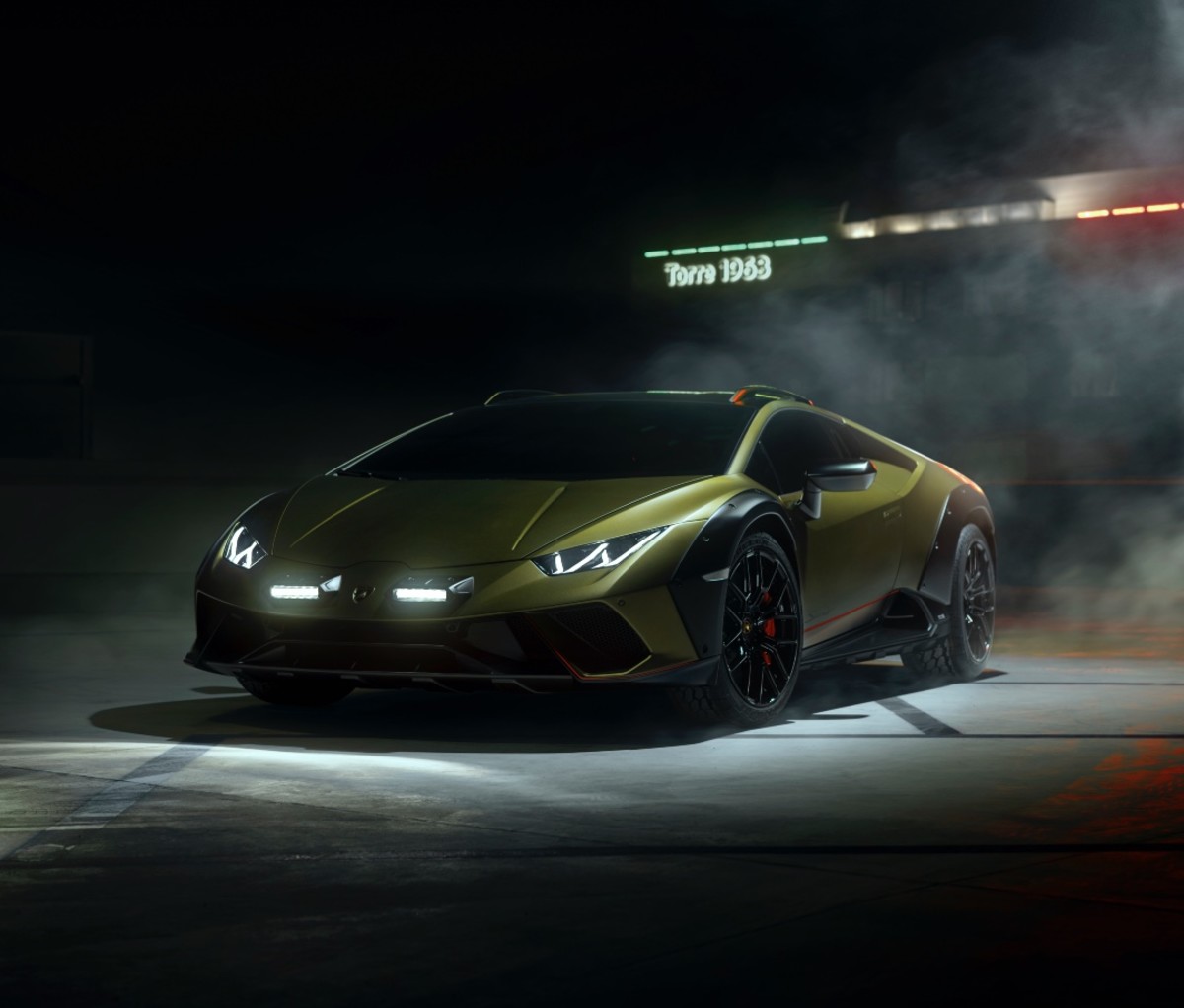Lamborghini aimed to take center stage at Art Basel Miami Beach this year by unveiling a new off-roading version of the angular Huracán supercar, dubbed the Lamborghini Huracán Sterrato. Equipped with lifted suspension, fender flares, and knobby tires, the Sterrato marks the final iteration of Lambo’s quintessential naturally aspirated V10 engine before forthcoming generations introduce hybrid and full electric powertrains. A rally-ready variant of the lows-lung, angular Huracán arrives straight out of left field—other than supposed “leaks” and teasers ahead of the official debut—so ahead of the debut, I spoke with CTO Rouven Mohr about making such a big departure from Lamborghini’s traditional recipes.
Perhaps unsurprisingly, Mohr reveres the glory days of rally racing and even owns a Mitsubishi Lancer Evolution done up with mud flaps and the works. Now in his second stint at Lamborghini, Mohr’s involvement with the Sterrato’s evolution began over five years ago as the earliest seeds of the project first sprouted.
“I remember pretty well the event where the idea was born,” he told Men’s Journal. “It was August or September 2017, when we were testing the Urus. We built close to the track of Vallelunga this small off-road, tiny track that basically was not there when we started.”
After a day spent testing the Urus SUV on that dirt circuit next, Mohr and his boss at the time, Maurizio Reggiani, experienced a lightbulb moment while sitting at a pizzeria.
“Everyone was so in love with this driving experience,” Mohr told me, “And we said, ‘Ah, unfortunately 99 percent of the customers will never use the Urus like this.’ Then we were thinking about the good old times, the rally times, and then I don’t know who, but one of us said it would be even cooler to drive this kind of thing with one of our super sports cars.”
But the chances of actually bringing such a fever dream to reality seemed quite remote—until Mohr showed a bit of initiative.
“At the beginning, not everyone was sure if this made sense or not,” he said. “I was looking for an old Huracán because we had a lot of cars that we had finishing the durability tests, so more or less they were close to being scrapped. I took one and together with my team, we built the demo car. Then we tested the car, and everyone was jumping out with a big, big smile on their face. So this was the starting point.”
Priorities shifted at Lamborghini quickly after the Urus SUV debuted to smashing sales success. Mohr ended up leaving for a few years at Audi before returning to Sant’Agata Bolognese in January 2022. At the time, new CEO Stephan Winkelmann brought up the off-roading Huracán as an eminently marketable project and Mohr jumped at the opportunity to bring his dreams to life.

Everything Started with the Suspension
Transforming a track scalpel like the Huracán into an aggressive lifted off-roader required a ton of revisions to the original car. The Sterrato chassis allows for 34 millimeters more of ground clearance, as well as more suspension travel at all for corners.
“It’s important to understand the mission of the car,” he explained. “Everything started with the suspension. Basically, it’s not really an off-roader. I mean, for sure, you can drive off-road, but it’s more. I call it ‘off-track’ because the main mission of the car was to transfer the thrill and the driving emotions that you have with a super sports car like STO to low-grip conditions where you can drift and where you can better play with the car.”
I asked if the suspension modifications include adjustable ride heights, as in the “base” Urus and the new Urus S—and in contrast to the more traditional steel springs of the Urus Performante.
“No, it’s not adjustable,” Mohr replied, before joking, “We don’t want to build a kind of lame duck that at the end of the day is able to do the Rubicon Trail. I mean, it’s unrealistic.”
The Huracán already employs double-wishbone suspension that allows for significant suspension travel without creating excessive camber issues, so new dampers and springs make up most of the changes to an already very taut chassis.
“We are lucky because the basic car is already, let me say, stiffness-oriented,” Mohr said. “If you want to go sideways, if you want to really slide through the corners, this desire for driving behavior defined the ride height. If you go too too high, you have to make too many discounts because then you have a lot of body rolling, or you need stiffer springs to avoid this because the center of gravity is higher.”
“In this car, we did exactly the opposite of what we usually do in our super sports cars,” he said, “less stiffness of the springs, less damper force, more movement of the car.”
The control arms themselves required minor modifications for tire clearance and damper connection angles, which allowed Lamborghini to fit 19-inch wheels shod in higher-profile Bridgestone Dueler AT002 tires measuring 235mm up front and 285mm in the rear. A set of fender flares allow for a wider stance, and the track width stretched by 30mm and 34mm, respectively. But those specs actually represent a step back from the original demo car that Mohr built years prior.
“Originally, the tire diameter was even higher, but the consequence of this was that the front axle had to be moved a lot to the front to ensure the turning circle and also to fit the tire in the wheelhouse,” he explained. “Aesthetically, it was a little bit strange if you looked on the side. It was a nice car, but it was not so nice like the production car. Therefore, we took the compromise in the standard production car that the wheelbase is still a little bit higher, but only few millimeters because the tire diameter is a little bit smaller again.”
Balancing aesthetics with performance, both on-road and in the slippery stuff, required plenty of fiddling. Mohr now sounds confident that the Sterrato delivers exactly the feelings a Lamborghini should, but with a new level of comfort and capability.
“At the end of the day, the toughest part is, from the setup point of view, to have a car that you can drive on Nardò or on all the race tracks of the world, and have fun. You don’t feel uncomfortable because you feel still connected to the car. And on the other side, you go with the same car, with the same tire on gravel or snow and you drive like the rally heroes of the ’80s.”
But if 99 percent of Urus customers will never take their six-figures super SUVs off-roading, as Reggiani and Mohr lamented in 2017, I suggested that even fewer Huracán drivers will these days.
“You can imagine, even if the customer will not drift with the car in the gravel,” Mohr replied, “You don’t have to be worried about speed bumps or pot holes on the road. The car is more robust and it’s really more practical than the standard super sports car. But you still have the same involvement.”

Recalibrating the Naturally Aspirated V10
Much of the adoration that Lamborghini inspires among devotees stems from the brand’s longstanding adherence to naturally aspirated V10 and V12 engines. But larger-diameter tires mean less power put to the ground, in sheer physics terms. So how does the Sterrato’s drivetrain counter the necessary power decrease?
“The engine calibration is different,” Mohr told me. “The main idea was to have this kind of high screaming, naturally aspirated high revving.”
Mounted amidship in the Sterrato, the Huracán’s highest-spec 5.2-liter V10 cranks out 610 horsepower and 417 lb-ft of torque. That’s a minimal decrease from 630 horses out of the same mill when used in the STO, and it’s largely due to using a roof scoop air intake to reduce the amount of potential dust and dirt entering the engine.
“We recognized during the testing activities of the demo car that with the air intake at the height of the rear windows, like the standard Huracán, the air filters were completely, permanently blocked,” Mohr said. “On the STO, the air scoop is only for cooling purposes, and the air intake is still on the side. In the Sterrato, the air scoop is really the air intake to the engine, and we also have completely revised the air filter concept to be as robust as possible. And based on this, we have a little bit more pressure loss in the intake system. And the result is that the engine power is a little bit less.”
The STO also comes in rear-wheel drive only, while the Sterrato still employs another trademark of Lamborghini handling: an electronically controlled all-wheel-drive system equipped with a mechanical limited-slip rear differential. But unlike other AWD Huracáns, the Sterrato does not come with rear-wheel-steering.
“The combination of rear steering and a little bit softer tire compound,” explains Mohr, “gives too artificial of a feeling.”
Surprisingly, as on the Uruses (Urii?) that Mohr played with in the sandbox at Vallelunga, the new Huracán variant also hides carbon ceramic brakes beneath those 19-inch wheels—in this case, measuring 380mm up front and 356mm at the rear. Just try not to think about the sound of a pebble getting caught in the brake caliper during some dirt-road drifting.

The Rally Craze Reaches a Crescendo
The courage required to take a modern supercar off the asphalt sounds immense. Just ask anyone who signed up to purchase Porsche’s recently unveiled 911 Dakar, which stickers at $220,000 and up. I asked Mohr if the Porsche figured into Lamborghini’s decision to build the Sterrato, given the shared Volkswagen AG ownership and his own Audi past. Not at all, it turns out.
“For Porsche, it’s a kind of renewal of the history of the famous and very successful ‘Safari’ 911, but it’s a different category of car, for sure,” Mohr reflected. “If you drive this car on the track and then enter the infield, like rallycross style, it’s fun. And this fits to our brand.”
Little details also contribute to the Sterrato’s otherwise aggressive profile. Mohr’s personal favorite? The dual front accessory light bars.
“Rally cars always had these additional headlamps on the front and we wanted to bring this also,” he laughed. “I’m so in love with these additional headlamps, even if they are not needed. Also, in the U.S., they have to be covered.”
As a dedicated rally enthusiast with his own Evo, surely Mohr took the Sterrato out on some hard technical trails, I thought.
“I can tell you in Sweden, when we made the winter testing in the test area, there are also some forest roads you can drive so fast in the car because it’s easy,” Mohr admitted. “On this low-grip surface, it takes some time until the car is stopping. I had to remember, ‘Oh, it’s still gravel or snow you’re driving.’”
Although such dedicated development fun might sound likely to spawn a factory-supported rally racing program, Mohr shot down such an idea as taking away too much attention from Lamborghini’s focus on next-generation LMDh and Super Trofeo cars. But he and I both agreed that hopefully, at least a few of the lucky customers willing to shell out for a Sterrato will take this last Huracán out for some drifting in the grit and grime.
from Men's Journal https://ift.tt/tU5sFzM





No comments:
Post a Comment